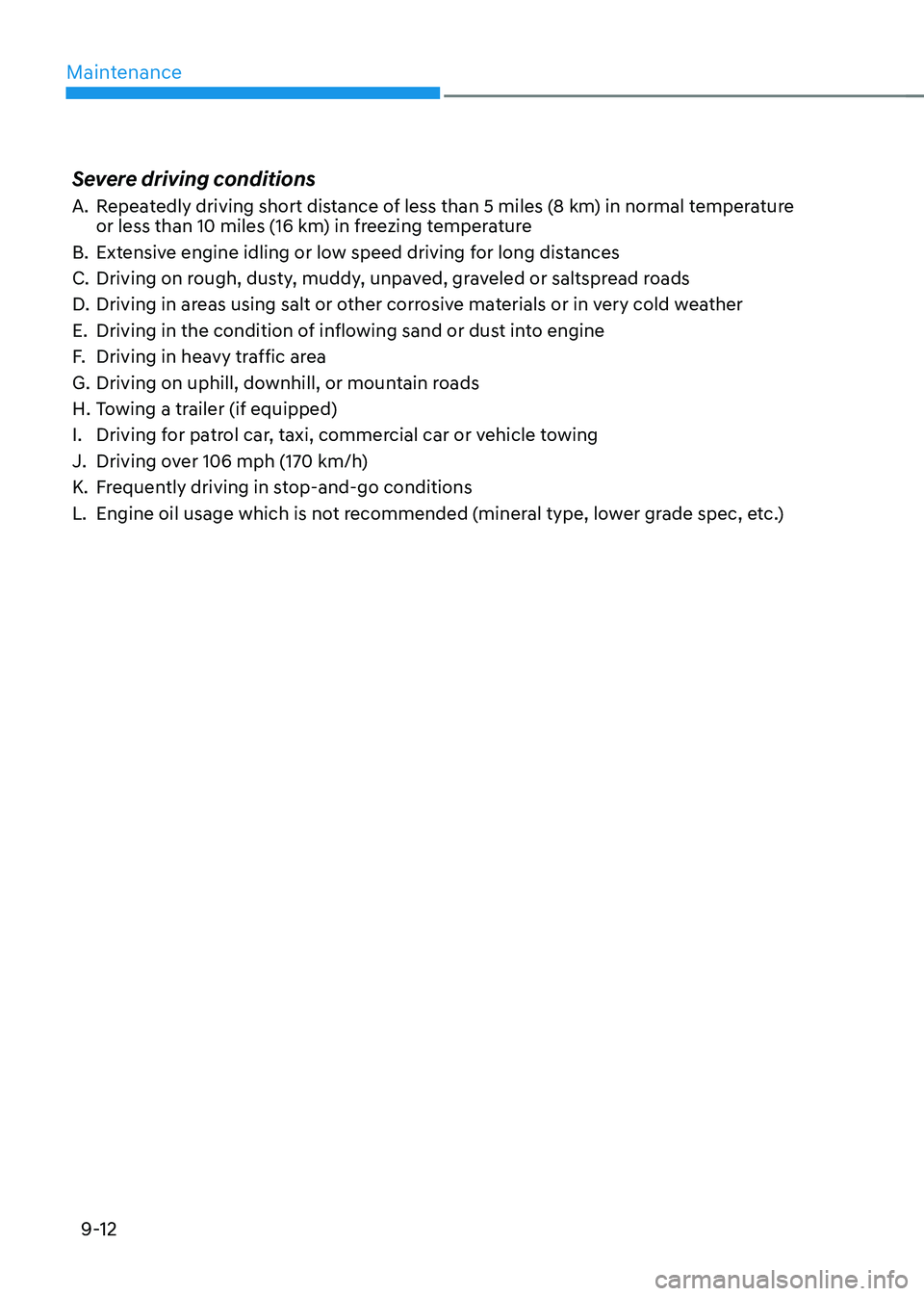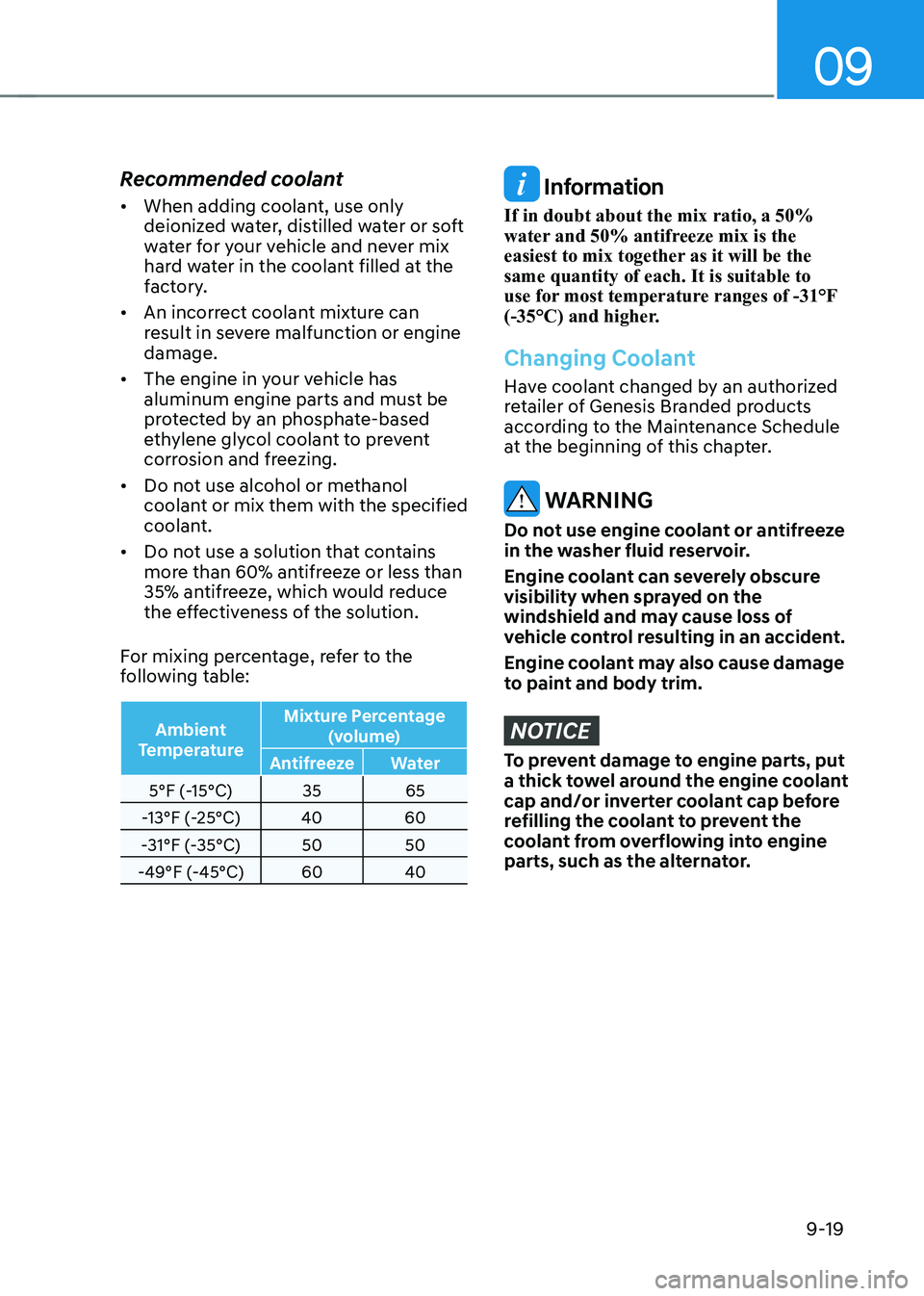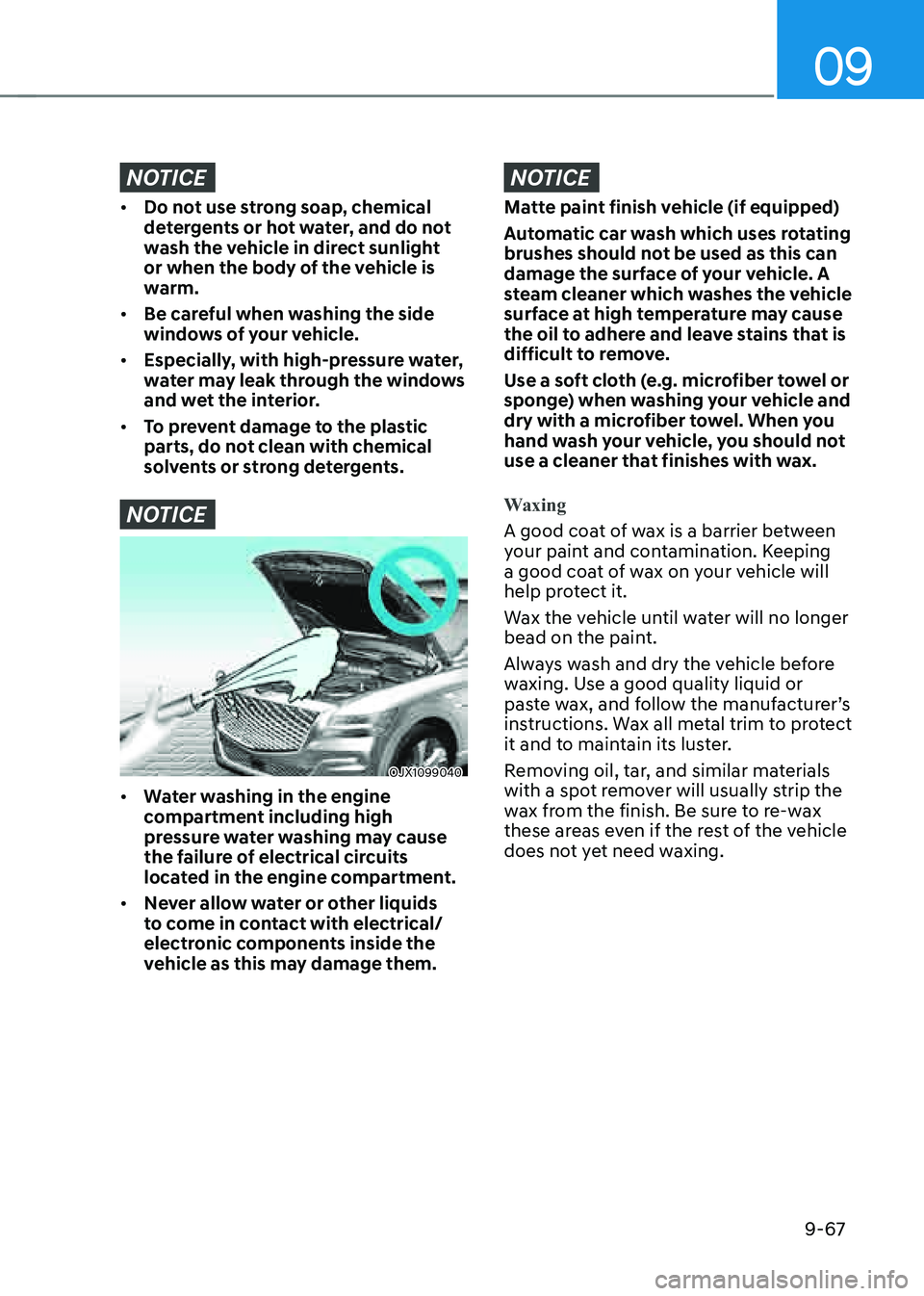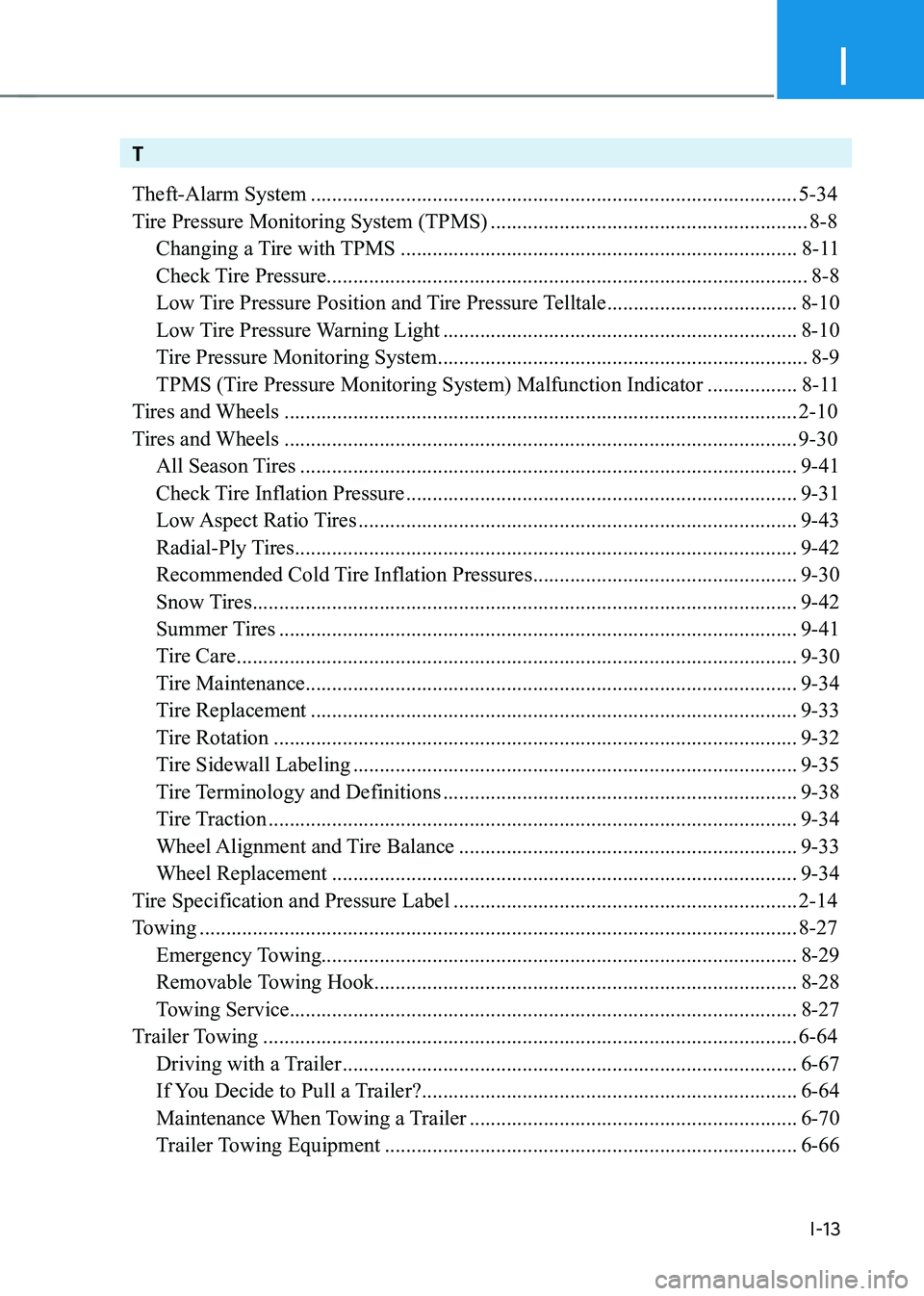tow GENESIS GV80 2021 Repair Manual
[x] Cancel search | Manufacturer: GENESIS, Model Year: 2021, Model line: GV80, Model: GENESIS GV80 2021Pages: 632, PDF Size: 9.37 MB
Page 548 of 632

09
9 -7
Follow Normal Maintenance Schedule if the vehicle is usually operated where none of
the following conditions apply. If any of the following conditions apply, you must follow
the Maintenance Under Severe Usage Conditions.
• Repeated driving short distance of less than 5 miles (8 km) in normal temperature or
less than 10 miles (16 km) in freezing temperature
• Extensive engine idling or low speed driving for long distances
• Driving on rough, dusty, muddy, unpaved, graveled or salt-spread roads
• Driving in areas using salt or other corrosive materials or in very cold weather
• Driving in heavy dust conditions
• Driving in heavy traffic area
• Driving on uphill, downhill, or mountain road repeatedly
• Towing a trailer or using a camper, or roof rack
• Driving as a patrol car, taxi, other commercial use of vehicle towing
• Driving over 106 mph (170 km/h)
• Frequently driving in stop-and-go condition
• Engine oil usage which is not recommended (mineral type, lower grade spec, etc.)
If your vehicle is operated under the above conditions, you should inspect, replace
or refill more frequently than the following Normal Maintenance Schedule. After the
periods or distance shown in the chart, continue to follow the prescribed maintenance
intervals.
NOTICE
After 10 years or 100,000 miles, we recommend to use severe maintenance
schedule.
SCHEDULED MAINTENANCE SERVICES
Page 553 of 632

Maintenance
9-12
Severe driving conditions
A. Repeatedly driving short distance of less than 5 miles (8 km) in normal temperature
or less than 10 miles (16 km) in freezing temperature
B. Extensive engine idling or low speed driving for long distances
C. Driving on rough, dusty, muddy, unpaved, graveled or saltspread roads
D. Driving in areas using salt or other corrosive materials or in very cold weather
E. Driving in the condition of inflowing sand or dust into engine
F. Driving in heavy traffic area
G. Driving on uphill, downhill, or mountain roads
H. Towing a trailer (if equipped)
I. Driving for patrol car, taxi, commercial car or vehicle towing
J. Driving over 106 mph (170 km/h)
K. Frequently driving in stop-and-go conditions
L. Engine oil usage which is not recommended (mineral type, lower grade spec, etc.)
Page 560 of 632

09
9-19
Recommended coolant
• When adding coolant, use only
deionized water, distilled water or soft
water for your vehicle and never mix
hard water in the coolant filled at the
factory.
• An incorrect coolant mixture can
result in severe malfunction or engine
damage.
• The engine in your vehicle has
aluminum engine parts and must be
protected by an phosphate-based
ethylene glycol coolant to prevent
corrosion and freezing.
• Do not use alcohol or methanol
coolant or mix them with the specified
coolant.
• Do not use a solution that contains
more than 60% antifreeze or less than
35% antifreeze, which would reduce
the effectiveness of the solution.
For mixing percentage, refer to the
following table:
Ambient
Temperature Mixture Percentage
(volume)
Antifreeze Water
5°F (-15°C) 3565
-13°F (-25°C) 4060
-31°F (-35°C) 5050
-49°F (-45°C) 6040
Information
If in doubt about the mix ratio, a 50%
water and 50% antifreeze mix is the
easiest to mix together as it will be the
same quantity of each. It is suitable to
use for most temperature ranges of -31°F
(-35°C) and higher.
Changing Coolant
Have coolant changed by an authorized
retailer of Genesis Branded products
according to the Maintenance Schedule
at the beginning of this chapter.
WARNING
Do not use engine coolant or antifreeze
in the washer fluid reservoir.
Engine coolant can severely obscure
visibility when sprayed on the
windshield and may cause loss of
vehicle control resulting in an accident.
Engine coolant may also cause damage
to paint and body trim.
NOTICE
To prevent damage to engine parts, put
a thick towel around the engine coolant
cap and/or inverter coolant cap before
refilling the coolant to prevent the
coolant from overflowing into engine
parts, such as the alternator.
Page 608 of 632

09
9-67
NOTICE
• Do not use strong soap, chemical
detergents or hot water, and do not
wash the vehicle in direct sunlight
or when the body of the vehicle is
warm.
• Be careful when washing the side
windows of your vehicle.
• Especially, with high-pressure water,
water may leak through the windows
and wet the interior.
• To prevent damage to the plastic
parts, do not clean with chemical
solvents or strong detergents.
NOTICE
OJX1099040OJX1099040
• Water washing in the engine
compartment including high
pressure water washing may cause
the failure of electrical circuits
located in the engine compartment.
• Never allow water or other liquids
to come in contact with electrical/
electronic components inside the
vehicle as this may damage them.
NOTICE
Matte paint finish vehicle (if equipped)
Automatic car wash which uses rotating
brushes should not be used as this can
damage the surface of your vehicle. A
steam cleaner which washes the vehicle
surface at high temperature may cause
the oil to adhere and leave stains that is
difficult to remove.
Use a soft cloth (e.g. microfiber towel or
sponge) when washing your vehicle and
dry with a microfiber towel. When you
hand wash your vehicle, you should not
use a cleaner that finishes with wax.
Waxing
A good coat of wax is a barrier between
your paint and contamination. Keeping
a good coat of wax on your vehicle will
help protect it.
Wax the vehicle until water will no longer
bead on the paint.
Always wash and dry the vehicle before
waxing. Use a good quality liquid or
paste wax, and follow the manufacturer’s
instructions. Wax all metal trim to protect
it and to maintain its luster.
Removing oil, tar, and similar materials
with a spot remover will usually strip the
wax from the finish. Be sure to re-wax
these areas even if the rest of the vehicle
does not yet need waxing.
Page 631 of 632

I
I-13
T
Theft-Alarm System
........................................................................\
....................5-34
Tire Pressure Monitoring System (TPMS)
............................................................8-8
Changing a Tire with TPMS
........................................................................\
...8-11
Check Tire Pressure ........................................................................\
................... 8-8
Low Tire Pressure Position and Tire Pressure Telltale
....................................8-10
Low Tire Pressure Warning Light
...................................................................8-10
Tire Pressure Monitoring System
......................................................................8-9
TPMS (Tire Pressure Monitoring System) Malfunction Indicator
.................8-11
Tires and Wheels
........................................................................\
.........................2-10
Tires and Wheels
........................................................................\
.........................9-30
All Season Tires
........................................................................\
......................9-41
Check Tire Inflation Pressure
........................................................................\
..9-31
Low Aspect Ratio Tires
........................................................................\
...........9-43
Radial-Ply Tires
........................................................................\
.......................9-42
Recommended Cold Tire Inflation Pressures
..................................................9-30
Snow Tires
........................................................................\
...............................9-42
Summer Tires
........................................................................\
..........................9-41
Tire Care
........................................................................\
..................................9-30
Tire Maintenance
........................................................................\
.....................9-34
Tire Replacement
........................................................................\
....................9-33
Tire Rotation
........................................................................\
...........................9-32
Tire Sidewall Labeling
........................................................................\
............9-35
Tire Terminology and Definitions
...................................................................9-38
Tire Traction
........................................................................\
............................9-34
Wheel Alignment and Tire Balance
................................................................9-33
Wheel Replacement
........................................................................\
................9-34
Tire Specification and Pressure Label
.................................................................2-14
Towing
........................................................................\
.........................................8-27
Emergency Towing ........................................................................\
.................. 8-29
Removable Towing Hook........................................................................\
........ 8-28
Towing Service
........................................................................\
........................8-27
Trailer Towing
........................................................................\
.............................6-64
Driving with a Trailer
........................................................................\
..............6-67
If You Decide to Pull a Trailer?
.......................................................................6-64
Maintenance When Towing a Trailer
..............................................................6-70
Trailer Towing Equipment
........................................................................\
......6-66